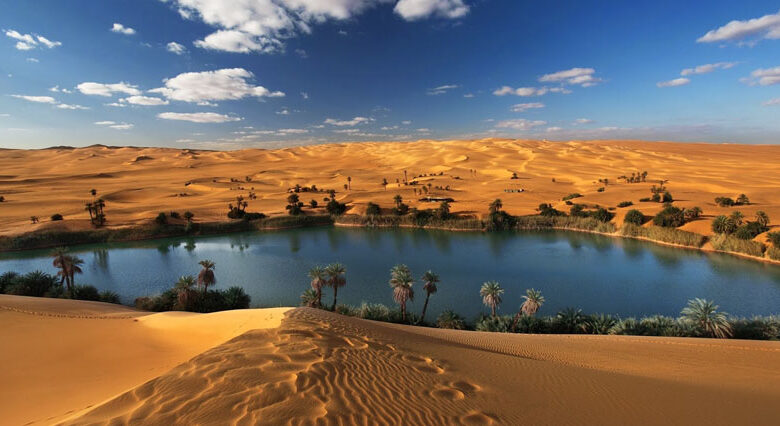Who created oases? Oldest, most extensive and facts about islands in the desert

For the modern person, an oasis is a beautiful picture that complements the landscapes of deserts. In the past, over the millennia, the role of this island of prosperity and fertility was much more severe.
For the oases had to fight – not only with the relentless nature but also with opponents in human form.
Why and how oases appeared and when people started using them
The desert is a harsh environment for both people and animals placed at the service of human interests. The air temperature during the day reaches and exceeds 50 degrees Celsius, and the lack of water for many kilometres makes any journey through the sands a deadly enterprise.
Therefore, the role of oases cannot be overestimated – this is a chance for travellers to rebuild their strength and water the beasts of burden, which most often became a means of moving through the desert. And also an opportunity to strengthen your political power, because the one who controls the oasis becomes a very influential figure.
The sands of the Sahara, the Arabian Peninsula, the deserts of Asia, North and South America, red-hot under the scorching sun, left no chance for any artificial reservoirs. Watering plants in such conditions is a highly wasteful activity: water evaporates too quickly or goes into sandy soil. But oases of even the driest regions of the globe have managed to exist for centuries, sometimes even millennia – for some of them, the threat of extinction has arisen only now, in the 21st century. How did nature manage to preserve these islands of coolness and fertility where it seemed as impossible as necessary?
The secret of the oasis lies in the shallow bedding of underground rivers: the water rises so close to the earth’s surface (sometimes under the influence of its pressure) that a reservoir appears. Its preservation is often aided by solid rock formations that create a watertight bottom. Birds and animals arriving at the oasis for a watering-place bring seeds on themselves, which germinate once in relatively fertile soil – this is how an island of greenery is formed. Occasional rains also support the oases.
Traces of the word “oasis” can be traced back to Ancient Egypt; it got into the modern language from Greek through Latin – and therefore, it is easy to guess that these green islands in the desert were of particular interest to humanity many centuries ago. Moreover – there is evidence that the oases were inhabited in the prehistoric era – this is evidenced by the rock paintings found in them, but, of course, the term used to refer to the oases at that time has not survived. And in primitive times, and then tight reservoirs in the desert, settlements arose, and in addition, these areas became essential components of caravan routes.
How the oases were used: Sahara
One of the largest desert in the world – the Sahara – for all its dissimilarity to the environment favourable for human activity, was, nevertheless, a relatively developed network of trade routes of the past – starting from the fourth millennium BC. and ending with relatively recent times, the beginning of the XX century. The Sahara was crossed “both along and across” – and from south to north and west to east. Gold and precious stones, rock salt, ivory, animal skins, and slaves were exported from the depths of Africa. In return, they brought in textiles and other achievements of European and Middle Eastern civilization.
Crossing the Sahara and back was not a quick affair and took about one and a half years. The routes were laid based on the location of the oases; Berbers, the indigenous inhabitants of North Africa, were taken as guides. Those have long learned, by the way, to use the possibilities of oases, not only to preserve them but also to make the most of this miracle – or gift – of nature.
Farming was organized “in three layers”: date palms became the tallest plants on the territory of the oasis, they formed the “upper tier”. Below, in the shade of broad palm leaves protected from the fierce desert sun, peach, citrus, and other fruit trees grew. And vegetables and cereals made up the “lower tier” – they were grown where there was the most moisture.
Since the traditional method of irrigation – even if there was a nearby reservoir – would lead to disproportionately high water consumption with a small planting area, a different approach was used in the deserts: holes were dug for palms and other garden trees that did not reach the groundwater level of about a meter. The soil turned out to be moistened “from below”, and the roots, which earned a certain length, had unlimited access to water.
The Trans-Saharan trade in the Middle Ages is impressive in its scale: one caravan, on average, consisted of a thousand camels, and often more. Control over the oases also meant control over trade routes, and therefore it is not surprising that the settlements near the oases often became the arena of military conflicts. In the 16th century, as a result of the wars that engulfed the northern part of the African continent and the onset of the era of the Great Geographical Discoveries, the caravan trade in the Sahara fell into decay but did not completely stop.
Oases of other deserts, unique in their landscape and history
Thanks to the oases, the Sahara has become not the only desert that man has mastered since time immemorial. The Bible mentions the oasis city of Ein Gedi, located in the Judean Desert and famous for its incense, vineyards, dates and figs. The history of this settlement is lost as early as the 7th century BC. It underwent either destruction or restoration throughout its history until, in the 6th century, it was finally destroyed by the Arab conquerors. Now a nature reserve and a national park have been organized at this place.
Another current reserve, Azraq, exists east of Amman, the capital of Jordan. It looks not quite typical for an oasis. It is distinguished not by palm trees but by a marshland, more reminiscent of landscapes of temperate latitudes. Like other ancient oases, Azraq is also a place of cultural pilgrimage – here are the ruins of a fortress, first erected by the Romans.
Al Ain, the only large city in the UAE located far from the sea coast, is again found in the oasis area. In Al-Ain, you can see one of the oldest mosques on the peninsula, more precisely, its ruins: their age is more than a thousand years. And the largest oasis in the world – Al-Ahsa, is located in Saudi Arabia, where you can see 280 springs and two and a half million trees.
The study of the past of the peoples living in the desert provides fantastic information. For example, it was found that to increase the productivity of the oasis in the Atacama Desert (in the territory of present-day Chile), local tribes especially collected and transported more than a hundred kilometres of coastal seabird droppings. This happened back in the first millennium, before the arrival of the Incas and especially the Europeans in these lands.
The territory of Las Vegas, the capital of casinos and entertainment, was only a tiny oasis surrounded by a silent desert in the 19th century. In the first half of the 19th century, a trade caravan heading from Los Angeles to Texas went astray and stopped in the sands. In search of water, messengers were sent who discovered this oasis. The place was named “Las Vegas”, which means “the meadows” in Spanish.




